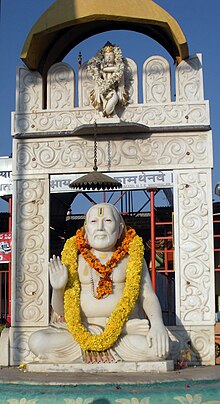Raghavendra Tirtha
| Sri Raghavendra Tirtha | |
|---|---|
 | |
| Religion | Hinduism |
| Philosophy | Dvaita |
| Personal | |
| Born | Venkata Natha 1595 or 1598 Bhuvanagiri (now in Tamil Nadu) |
| Died | 1671 Mantralayam (Now in Andhra Pradesh) |
| Spouse | Sarasvati |
| Children | Lakshminarayanacharya |
| Religious career | |
| Successor | Sri Yogendra Tirtha |
| Guru | Sudhindra Tirtha |
| Honors | Parimalacharya |
| Part of a series on |
| Dvaita |
|---|
 |
| Saints |
| Haridasas |
| Literature |
| Mathas |
|
| Holy Places |
| Hinduism portal |
Sri Rāghavēndra (c.1595–c.1671) was a Hindu scholar, theologian and saint. His diverse oeuvre include commentaries on the works of Madhva, Jayatirtha and Vyasatirtha, interpretation of the Principal Upanishads from the standpoint of Dvaita and a treatise on Purva Mimamsa. He served as the pontiff of the Madhvacharya Mutt at Kumbakonam from 1624 to 1671.[1] Raghavendra was also an accomplished player of the Veena and he composed several songs under the name of Venu Gopala.[2] His tomb at Mantralayam(Brindavana) attracts thousands of visitors every year.
Life[edit]
Raghavendra was born as Venkatanatha in the town of Bhuvanagiri, Tamil Nadu into a family of musicians and scholars. His great-grandfather Krishnabhattar was a tutor to Vijayanagara king Krishnadeva Raya and his father Timmanacharya was an accomplished scholar and musician.[3] After the fall of Vijayanagara empire, Timmanacharya migrated to Kanchi with his wife Gopikamba. Venkatanatha had two siblings: Gururaja and Venkatamba. Venkatanatha's education was undertaken by his brother-in-law Lakshminarasimhacharya, after the early demise of his father and he was subsequently married.[4]
According to Raghavendra Vijaya, his triumph in debates at Thanjavur attracted the attention of Sudhindra Tirtha, the erstwhile pontiff of Kumbakonam mutt.[5] [6] Though initially uncertain about the prospect of renunciation, Venkatanatha relented to Sudhindra's demands and was ordained as a monk in 1621.[4] After the passing away of Sudhindra Tirtha in 1623, Venkatanatha succeeded him as the pontiff the mutt and took on the name Raghavendra Tirtha. He undertook a pilgrimage visiting places including Udupi, Kolhapur and Bijapur.[7]He received grants from Dodda Kempadevaraja and settled down in the village of Mantralayam, which was presented to him by the Governor of Adoni. In 1801, while serving as the Collector of Bellary, Thomas Munro is believed to have come across an apparition of Raghavendra.[8][9] He died in 1671 and his mortal remains are enshrined in Mantralayam. Traditional accounts report that Raghavendra asked his tomb (Brindavana) to be built around him as he entered into a state of samadhi. He was succeeded by his disciple Yogeendra Tirtha.[6]
Works[edit]
Forty works have been attributed to Raghavendra.[2][9] Sharma notes that his works are characterised by their compactness, simplicity and their ability to explain the abstruse metaphysical concepts of Dvaita in understandable terms. [10][2] [9] His Tantradipika is an interpretation of the Brahma Sutra from the standpoint of Dvaita incorporating elements from Jayatirtha's Nyaya Sudha, Vyasatirtha'sTatparya Chandrika and the glosses by Vijayendra Tirtha. [10] Bhavadipa is a commentary on Jayatirtha's Tattva Prakasika which, apart from elucidating the concepts of the source text, criticises the allegations against Madhva raised by Appaya Dikshita and grammarian Bhattoji Dikshita. Raghavendra's expertise in Purva Mimamsa and Vyakarana is evident from his works on Vyasatirtha's Tatparya Chandrika, which runs up to 18,000 stanzas. He wrote a commentary on Nyaya Sudha titled Nyaya Sudha Parimala.[11] Apart from these works, he has authored commentaries on the Upanishads, first three chapters of Rig Veda (called Mantramanjari) and Bhagvad Gita. As an independent treatise, he has authored a commentary on Jaimini Sutras called Bhatta Sangraha which seeks to interpret the Purva Mimamsa doctrines from a Dvaita perspective.[12]
In culture[edit]
Raghavendra Tirtha has been eulogised by Narayanacharya in his contemporaneous biography Raghavendra Vijaya and a hymn Raghavendra Stotra by Appannacharya. Outside the confines of Dvaita, he is regarded as a saint known for preaching the worship of Vishnu regardless of caste or creed.[13] Hebbar notes "By virtue of his spiritual charisma, coupled with the innumerable miracles associated with him, the pontiff saint may very well be said to possess an independent and cosmopolitan cult of his own with his devotees hailing not only from all walks of life but from all castes, sects and even creeds as well".[14] His humanitarianism is evident in the devotional poems composed in his honour by Vijaya Dasa, Gopala Dasa and Jagannatha Dasa. [15] Raghavendra has also seen representation in the popular culture through Indian Cinema.
No comments:
Post a Comment